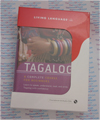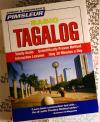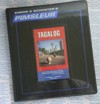Teach Yourself Complete Filipino Tagalog (Book+ 2CDs) Phillipines

Teach Yourself Complete Filipino (Tagalog)Book and 2 Audio CDsGet other Filipino Tagalog click here |
 |
Teach Yourself Complete Filipino Tagalog - 2 Audio CDs and BookBook and 2 CDs
The course is structured in thematic units and the emphasis is placed on communication, so that you effortlessly progress from introducing yourself and dealing with everyday situations, to using the phone and talking about work. By the end of this course, you will be at Level B2 of the Common European Framework for Languages: Can interact with a degree of fluency and spontaneity that makes regular interaction with native speakers quite possible without strain for either party. Learn effortlessly with a new easy-to-read page design and interactive features: NOT GOT MUCH TIME? AUTHOR INSIGHTS GRAMMAR TIPS USEFUL VOCABULARY DIALOGUES PRONUNCIATION TEST YOURSELF EXTEND YOUR KNOWLEDGE TRY THIS Comprehensive - all you need for speaking and understanding, reading and writing Tagalog. Table of Contents: About the Authors Cora Salvacion Castle, co-author, is an author, writer, translator and teacher of Tagalog. She is also the Tagalog editor of a Filipino newspaper in London. Laurence McGonnell is a member of St. Joseph's Missionary Society and spent six years living and working in the Philippines before returning to the UK to become Director of Studies at a north London College. He currently lives and teaches in the Philippines. About Tagalog Tagalog is one of the major languages of the Republic of the Philippines. It is the most spoken Philippine language in terms of the number of speakers. Tagalog, as its de facto standardized counterpart, Filipino, is the principal language of the national media in the Philippines. It is the primary language of public education. As Filipino, it is, along with English, a co-official language and the sole national language. Tagalog is widely used as a lingua franca throughout the country, and in overseas Filipino communities. However, while Tagalog may be prevalent in those fields, English, to varying degrees of fluency, is more prevalent in the fields of government and business. Tagalog History The word Tagalog derived from tagá-ílog, from tagá- meaning "native of" and ílog meaning "river", thus, it means "river dweller." There are no surviving written samples of Tagalog before the arrival of the Spanish in the 16th century. Very little is known about the history of the language. However, according to linguists such as Dr. David Zorc and Dr. Robert Blust, the Tagalogs originated, along with their Central Philippine cousins, from northeastern Mindanao or eastern Visayas The first known book to be written in Tagalog is the Doctrina Cristiana (Christian Doctrine) of 1593. It was written in Spanish and two versions of Tagalog; one written in Baybayin and the other in the Latin alphabet. Throughout the 333 years of Spanish occupation, there have been grammars and dictionaries written by Spanish clergymen such as Vocabulario de la Lengua Tagala by Pedro de San Buenaventura (Pila, Laguna, 1613), Vocabulario de la lengua tagala (1835) and Arte de la lengua tagala y manual tagalog para la adminstración de los Santos Sacramentos (1850). Poet Francisco "Balagtas" Baltazar (1788-1862) is regarded as the foremost Tagalog writer. His most famous work is the early 19th-century Florante at Laura. In 1937, Tagalog was selected as the basis of the national language by the National Language Institute. In 1959, Tagalog, which had been renamed Wikang Pambansa ("National Language") by President Manuel L. Quezon in 1939, was renamed by the Secretary of Education, Jose Romero, as Pilipino to give it a national rather than ethnicity label and connotation. The changing of the name did not, however, result in better acceptance at the conscious level among non-Tagalogs, especially Cebuanos who had not accepted the selection. In 1971, the language issue was revived once more,and a compromise solution was worked out — a ‘universalist’ approach to the national language, to be called Filipino rather than Pilipino. When a new constitution was drawn up in 1987, it named Filipino as the national language. The constitution specified that as that Filipino language evolves, it shall be further developed and enriched on the basis of existing Philippine and other languages. |
Teach Yourself Complete Filipino Tagalog - 2 Audio CDs and Book |

 0 Items (Empty)
0 Items (Empty)


